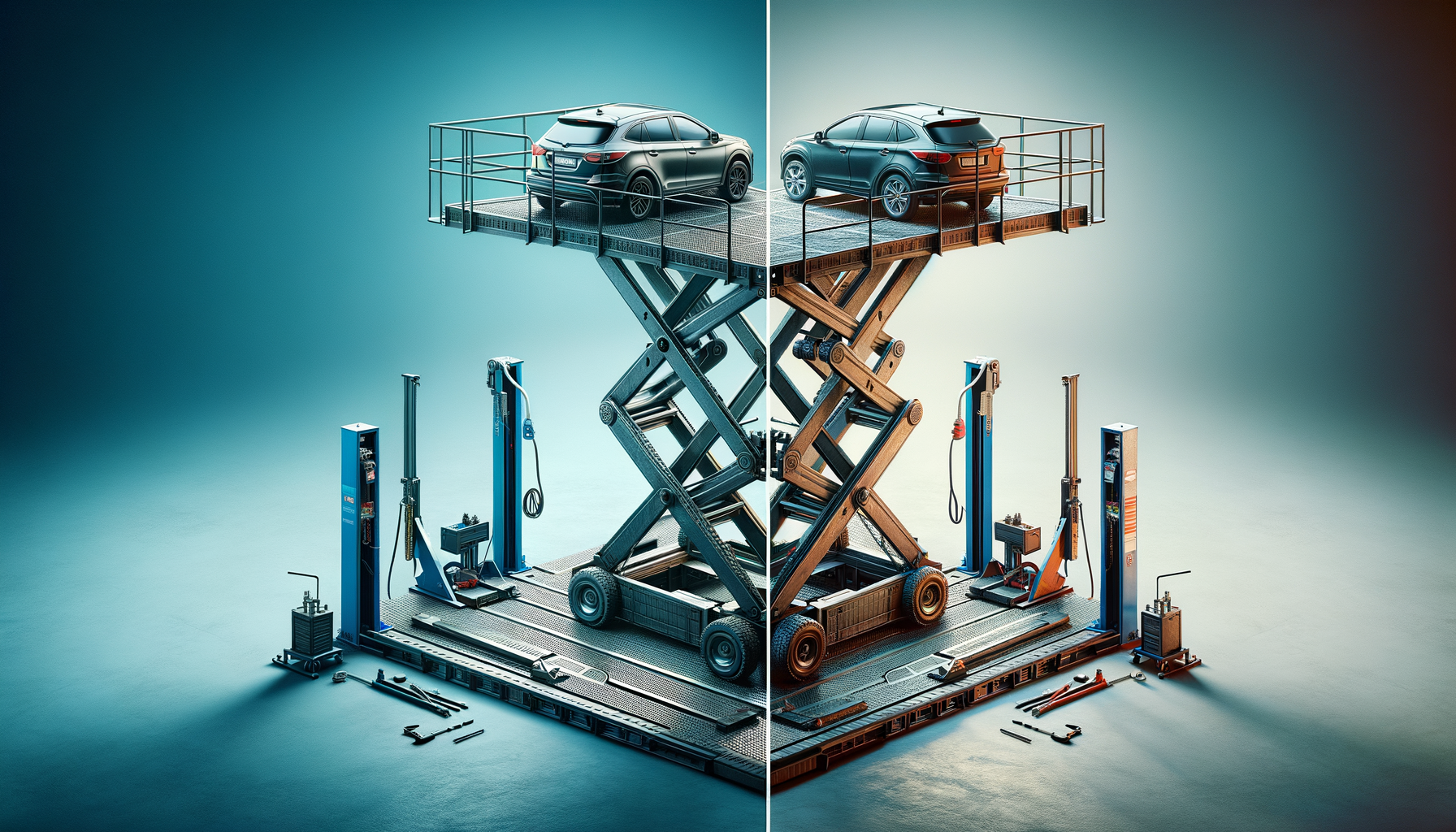Scissor Lift versus Car Lift: Determining the Right Choice for the DIY Mechanic
Are you a DIY mechanic or motor enthusiast? Working with a car lift can significantly simplify maintenance and repair tasks. But which type should you opt for – a scissor lift, a 4-post car lift, or a 2-post car lift? This guide dives into various car lifts for garages, enabling you to select an option that aligns with your requirements and financial plan.

Understanding Scissor Lifts
Scissor lifts are a popular choice among DIY mechanics due to their compact design and ease of use. These lifts are named for their crisscrossing metal supports that expand and contract in a scissor-like fashion, allowing vehicles to be lifted with stability. Scissor lifts are generally hydraulic-powered and can be portable or fixed, making them versatile for different garage setups.
The advantages of scissor lifts include their space-saving design, which is particularly beneficial for small garages. They can be easily stored when not in use, freeing up valuable floor space. Additionally, scissor lifts are often more affordable than other types of car lifts, making them an attractive option for budget-conscious mechanics.
However, there are some limitations to consider. Scissor lifts typically have a lower lifting capacity compared to 2-post or 4-post lifts. They may not be suitable for larger vehicles or heavy-duty work. Furthermore, the lifting height is often limited, which might restrict access to certain parts of the vehicle. Despite these drawbacks, scissor lifts remain a practical choice for many DIY enthusiasts who prioritize convenience and cost-effectiveness.
The Versatility of 2-Post Lifts
2-post lifts are renowned for their versatility and are a staple in many professional garages. These lifts consist of two sturdy posts with adjustable arms, allowing for a wide range of vehicle sizes to be accommodated. The open design provides excellent access to the undercarriage, making it ideal for tasks that require extensive work beneath the vehicle.
One of the key benefits of 2-post lifts is their high lifting capacity, which can handle most passenger vehicles and light trucks. This makes them suitable for various maintenance and repair tasks, from oil changes to suspension work. Additionally, the design allows for easy wheel servicing, as the wheels are left hanging freely when the vehicle is lifted.
However, 2-post lifts require a more permanent installation and a reinforced concrete floor to ensure stability. This might not be feasible for all home garages. Furthermore, the initial cost and installation can be higher than that of scissor lifts. Despite these considerations, the 2-post lift’s adaptability and robust performance make it a favored choice among serious DIY mechanics.
Exploring the Stability of 4-Post Lifts
4-post lifts are known for their stability and ease of use, making them a popular option for both professional and home garages. Unlike 2-post lifts, 4-post lifts support the vehicle by its wheels, providing a stable platform for a wide range of vehicles, including larger trucks and SUVs.
The primary advantage of 4-post lifts is their exceptional stability, which is particularly beneficial for long-term storage or tasks that require precise alignment. They also typically have a higher weight capacity, accommodating heavier vehicles with ease. Additionally, the drive-on design simplifies the lifting process, as vehicles can be driven onto the lift without the need for precise positioning of lifting arms.
On the downside, 4-post lifts are larger and require more space, which may not be suitable for smaller garages. They can also be more expensive than scissor lifts, both in terms of initial purchase and installation. Despite these factors, the 4-post lift’s stability and ease of use make it a reliable choice for those with the space and budget to accommodate it.
Comparing Cost and Maintenance
When considering a car lift for your home garage, cost and maintenance are crucial factors. Scissor lifts are generally the most affordable option, with lower upfront costs and minimal maintenance requirements. Their simple design means fewer moving parts, reducing the likelihood of mechanical issues.
2-post lifts, while more expensive than scissor lifts, offer a good balance of cost and functionality. They require regular maintenance to ensure the hydraulic system and lifting arms are in good working order. However, their versatility and performance often justify the additional expense for dedicated DIY mechanics.
4-post lifts are typically the most expensive option, both in terms of purchase price and installation. They require regular maintenance to ensure the lifting cables and pulleys are functioning correctly. Despite the higher cost, their stability and ease of use provide excellent value for those who frequently work on larger vehicles or require long-term storage solutions.
Ultimately, the choice of lift will depend on your budget, garage space, and the type of work you plan to perform. Each lift type offers unique benefits and considerations, making it essential to evaluate your specific needs before making a decision.
Conclusion: Choosing the Right Lift for Your Needs
In conclusion, selecting the right car lift for your DIY garage involves carefully weighing the benefits and limitations of each type. Scissor lifts offer a compact and cost-effective solution for those with limited space and budget. 2-post lifts provide versatility and excellent access for a wide range of tasks, making them suitable for more serious mechanics. 4-post lifts deliver unparalleled stability and ease of use, ideal for larger vehicles and long-term storage.
Consider the types of vehicles you work on, the space available in your garage, and your budget when making your decision. By understanding the unique features and requirements of each lift type, you can choose the one that best aligns with your needs and enhances your DIY mechanic experience.